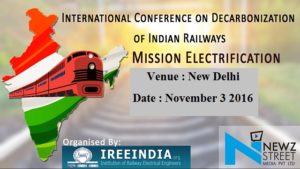Minister of Railways Shri Suresh Prabhakar Prabhu has inaugurated the International Conference on Decarbonisation of Indian Railways – Mission Electrification in New Delhi on November 3, 2016. It was organised by Institution of Railways Electrical Engineer (IREE) in partnership with ASSOCHAM India.
About Indian Railways :
Indian Railways(reporting mark IR) is an Indian state-owned enterprise, owned and operated by the Government of India through the Ministry of Railways. It is one of the world’s largest railway networks comprising 115,000 km (71,000 mi) of track over a route of 67,312 km (41,826 mi) and 7,112 stations.
- In 2015-16, IR carried 8.101 billion passengers annually or more than 22 million passengers a day and 1.107 billion tons of freight in the year. In 2014–2015 Indian Railways had revenues of₹1.709 trillion(US$25 billion) which consists of ₹1.118 trillion (US$17 billion) from freight and ₹451.26 billion (US$6.7 billion) from passengers tickets.
- Railways were first introduced to India in the year 1853 from Mumbai to Thane. In 1951 the systems were nationalised as one unit, the Indian Railways, becoming one of the largest networks in the world.
- IR operates both long distance and suburban rail systems on a multi-gauge network of broad, metre and narrow gauges.
- It also owns locomotive and coach production facilities at several places in India, with assigned codes identifying their gauge, kind of power and type of operation. Its operations cover twenty nine states and seven union territories and also provide limited international services to Nepal, Bangladesh and Pakistan.
- Indian Railways is the world’s seventh largest commercial or utility employer, by number of employees, with over 1.376 million employees as of last published figures in 2013.
- IR’srolling stock comprises over 245,267 Freight Wagons, 66,392 Passenger Coaches and 10,499 Locomotives (43 steam, 5,633 diesel and 4,823 electric locomotives).
- The trains have a 5 digit numbering system and runs 12,617 passenger trains and 7,421 freight trains daily.
- As of 31 March 2016, 27,999 km (17,398 mi) (41.59%) of the total 67,312 km (41,826 mi) route length was Since 1960, almost all electrified sections on IR use 25,000 Volt AC traction through overhead catenaries of delivery.
About International Conference,
Indian Railways is looking forward to make Railways greener by electrifying another 24000 km of Rail Tracks to the existing 28000 km in the next few years.
- The biggest user of energy Indian Railways consumes about 18 billion units of electricity and about 2.4 billion liters of fuel oil which is more than 2% of country’s energy consumption.

- Energy demand of Indian Railways is expected to triple by 2030 from current levels to 49 billion units of electricity. Decarbonising the Railways will help achieve the commitment made by India under Paris agreement to reduce its Green House Gas emissions by 33-35% by 2030 from the 2005 levels.
- The Railways will change significantly with the initiatives to produce greener energy & by electrifying the railways substantially. Consumption of imported oil will come down with electrification, thereby reducing burden on the exchequer.
- The Increase in the pace of electrification will reduce its fuel bill by Rs. 10000 Crore annually as against the business as usual approach.
- Indian Railways has embarked upon Mission Decarbonisation and Mission Electrification with an aim to reduce dependence on imported fuel and rationalize the cost of energy for Railways.
- The Conference aims at bringing various stakeholders on a common platform for exchange of ideas and to deliberate on implementable technological solutions and financing options to significantly increase pace of electrification and achieve the target for setting up of renewable energy installations with total capacity of 1000 MW by 2020.
- The Conference also projected Indian Railways as an attractive investment destination considering its plans for huge investment in next 5 years towards modernization of its electrified network and use of renewable energy.
- The Conference shall cover aspects relating to policy, technological modernization, mechanization, innovations and financing models for railway electrification and de-carbonization.
- National Transport Development Policy Committee (NTDPC), in its report, has identified electrification of railway tracks as a means to reduce fuel consumption.
- The report has recommended for taking up electrification on priority through systematically tackling the bottlenecks in progress of electrification projects.
- It has also suggested that electrification should be viewed as a means of making rail transport independent of imported fossil energy, while also provide a choice in sourcing energy.
New plans by Indian Railway :
- Suresh Prabhu launched a mobile app ‘RAIL SAVER’ to reduce energy consumption by 15 – 20%.
- It has been decided to manufacture electric locos from DLW, Varanasi
- New energy efficient Rolling Stock has been initiated
- It have introduced HOG system wherein the lighting, air-conditioning and other electrical loads of passenger coaches would be fed directly from electric power drawn by locomotive from grid.
Railways set target of 100% de-carbonisation, 90% electrification in next 5 yrs
The Indian Railways has set a target to achieve 100 per cent de-carbonisation, with 90 per cent electrification in next five years.
- With the investment of Rs 25,000 crore, electrification of nearly 25,000 kilometers will generate more employment for youth.
- This move also promote local manufacturer and vendor to support the Make in India endeavor of Prime Minister Narendra Modi.The electrification will reduce the fuel bill by Rs 10,000 crores annually as against the business as usual approach.






